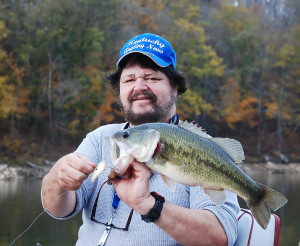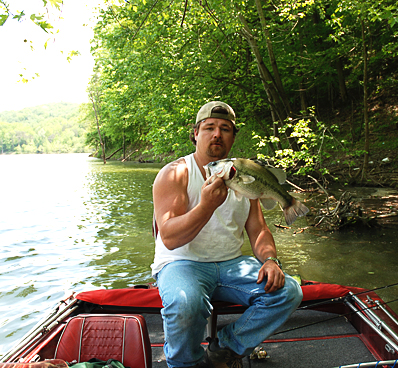By Chris Erwin
CAVE RUN LAKE When I left you last week, we had just wrapped up our first day of fishing. Once back at the camp my old friend Hershell Crum and I checked the weather report. It looked good until Thursday. Then it looked like we were in for a big storm. On Friday, I would be leaving for the main lake to attend the Kentucky Outdoor Press Association Writers’ Conference, so we had two more days to catch fish and I wanted to make the most of it.
On Monday, we had discovered the larger fish were relating to the channel. Banging away on the bank-line was a waste of time. Our task at this point was where we would start on Tuesday since we were limited to only using our trolling motor. Normally, I would go over a map looking for places, which held the same features as the area where we caught fish on Monday. However, our starting point was going to be where the boat was docked. The question was should I go up the river or down, and how in tree line should I position the boat?
One of the things we took note of was what time of day we caught fish and where. It became clear that between 4:30 p.m. and dark was the most productive period. However, we did catch fish all day but they were spaced out. It did matter to be in the right place at the right time.

Tuesday was calm. The water looked like a sheet of glass and the reflection of the fall trees set the water on fire with color. The cool air hit my face as the trolling motor moved us along so quietly I could hear every sound percolating from the forest. A long-necked crane sailed across the mouth of the cove and landed on a floating log just in front of me.
I was casting a ½ oz. rattletrap type lure, one of the lures we make. It’s shad color with yellow stripes and had served us well so far. It had become apparent that we needed to cast past the standing trees at an angle where the bait slides around the body of the tree. This action, where the bait bumps the tree body and slides around on its side produces a flutter that was provoking the fish to strike our bait.
Hershell had his 12-foot crappie rod in hand and was dropping a black and chartreuse colored 2-inch twister tail grub around each tree as we got to it. His success was good as he swung a crappie in the boat every few minutes. My success was spaced out; I was catching a fish every 10 to 15 minutes.
The wind picked up only slightly as our boat glided along producing only a small ripple on the water. As we came to the end of the tree line, I cast past the break in the trees. As I turned watching Crum swing a crappie in to the boat, my rod thumped hard. I set the hook! The fish broke to the left and I saw my line cut a path across the glassy water. I leaned back and put pressure on the fish. I could feel it coming up.
“I think it’s a good one Hershell,” I proclaimed just as the bass breaks the water boiling on the top. My rod was bouncing in my hands and I could tell it was a good fish. Holding the rod high we both see the fish for the first time. Like singing harmony, we both say at the same time “that a good one”! The fish wrapped around a tree just under the water and I pinned the fish to it, as we moved in with the trolling motor. When I got close, I could see the fish was over five pounds. Holding pressure on the fish, she slides free and right into the net.
Our time on the water finishing on Thursday netted us about 42 fish. Our largest was 22 ½ inches. While we didn’t catch any muskie, our limited fishing area produced better than expected. Thanks for riding along with us!
Chris can be reached by email at trimmer308@windstream.net




Here is a link to a follow up on how we were using the bait you might fish this useful
http://kentuckyanglingforum.yuku.com/topic/15436/Cave-Run-Trip-part-2#.UozdGyeYyvk